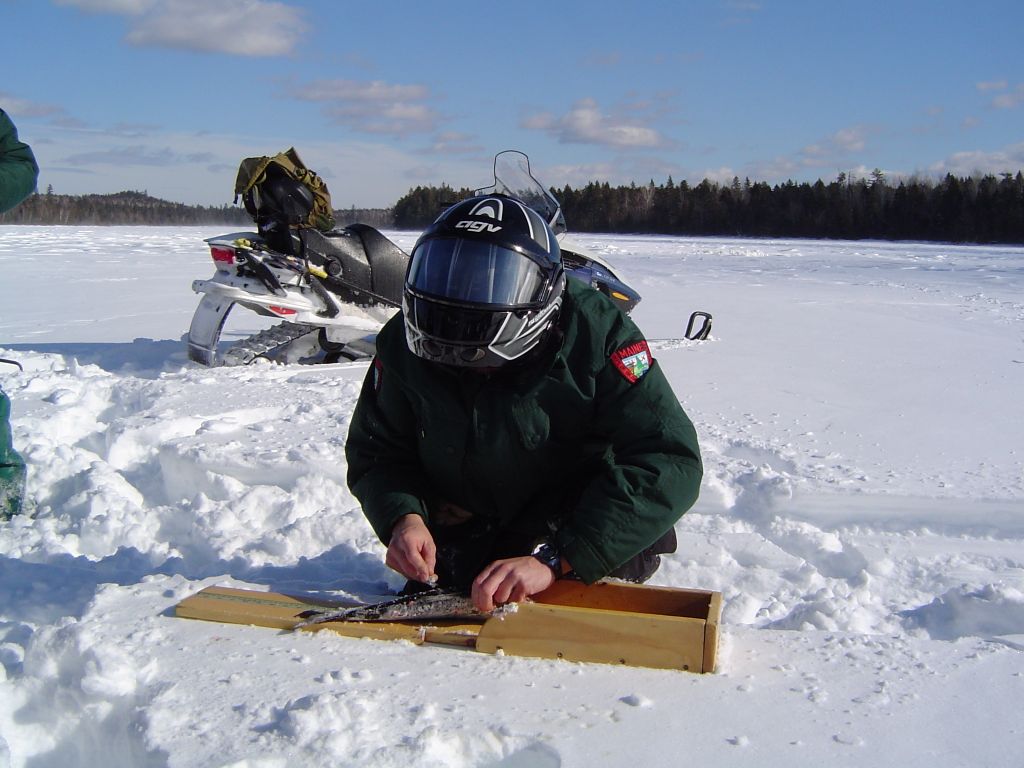January 12, 2021 at 5:41 pm
When you see the Maine Department of Inland Fisheries and Wildlife patch on the ice, it isn’t always a Maine Game Warden. Fisheries biologists spend the winter collecting important fisheries data by conducting winter creel surveys on the ice. Anglers can expect the biologist to ask a bunch of questions and the answers to those questions helps to determine the age and health of the fish, status of the fish population, winter-time angler use, as well as catch rates. The data collected helps to adjust stocking rates, bag limits, and adjust regulations as necessary. Creel survey is one of the few times we get to spend one-on-one with anglers in the field (see below for changes to this process to keep anglers and staff safe during the pandemic).

If you see a fisheries biologist this winter, you may be asked a few questions:
What is your name and where are you from?
Every good conversation starts with a good introduction and we usually take this opportunity to let you know who we are and what we are doing. Also, knowing where you are from gives us an idea about the users of the waterbody.
What time did you start?
Your fishing start time, used in addition to the time checked or the time you finish fishing is used to calculate catch rates.
How many people in your party?
This is used to calculate use estimates (since we can’t be there every day, we use a subsample to estimate the use for the entire season).
Any fish caught?
Used for calculating catch rates.
May I measure your fish?
– Length and weight measurements are used to evaluate the condition of the fish.
– The biologist may take a scale sample to age the fish (under a microscope scales can be read like the growth rings of a tree).
– For some longer-lived species the biologist may ask to remove the otoliths (an ear bone that can be examined under a microscope, often after taking a cross section, to determine the age of the fish). Some lake whitefish have been found to be 30+ years old!.
– The biologist may look in the stomach of the fish to see what their diet consists of.
Back trips (other previous trips on that or other waters)?
This information is used for all the data above.
Some biologists may ask for a phone number to get a completed trip for that day and others may hand out a card that can be returned via the mail to complete the data for that day.
-A completed trip would include the time after you were interviewed by the biologist until you finished fishing.
-Returning the creel cards is very helpful to complete the trip and give us the time you finished fishing as well as any fish you caught after we left. Often anglers say they will return these cards but typically we only see around 30-60%, we would love to see that number be 100%!
With the pandemic this year you may notice some changes. Face coverings will always be worn, and biologists will not be entering camps or ice shacks. We will be staying at least six feet away from all anglers to ensure the safety of anglers and staff. We will not be handing out creel cards this year to prevent contact with each other. Interactions will be limited to less than 15 minutes and larger groups (greater than 10) will be skipped.
Anglers often enjoy the opportunity to talk with a fisheries biologist and get some satisfaction out of the fact that the information they give can help improve the fishery. For anglers hoping to help biologists throughout 2021, they can keep a yearly voluntary record book. If interested, contact a regional biologist near you to receive a record book. We coordinate with each other, so no matter where you fish throughout the year, your information will get to the right place. We will send you a log book with instructions, and a return envelope with postage at the end of each season.
As always, make sure the ice is safe before venturing out and make sure you have consulted the lawbook or use the Fishing Laws Online Angling Tool (FLOAT). Flag!